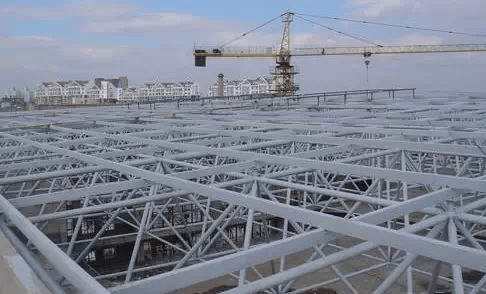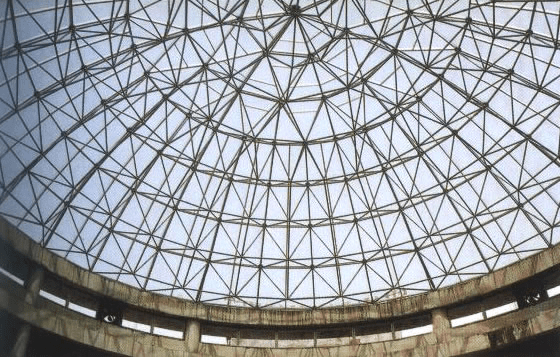QR Code

The spatial grid structure can be divided into double-layer plate-type spatial grid structure, single-layer and double-layer shell-type spatial grid structure. The rods of plate-type spatial grid and double-layer shell-type spatial grid are divided into upper chord rod, lower chord rod and web rod, which mainly bear tensile force and pressure. The nodes of single-layer shell-type spatial grid are generally assumed to be rigidly connected, and should be calculated according to the finite element method of rigidly connected rod system; double-layer shell-type spatial grid can be calculated according to the finite element method of articulated rod system. Single and double shell type spatial grid can also be used to simplify the calculation of the proposed shell method.

The rods of single-layer shell-type spatial grid, in addition to bearing tension and pressure, also bear bending moment and shear force. At present, the vast majority of China's grid structure adopts plate-type grid structure. Grid structure is a kind of space grid structure. The so-called “space structure” is relative to the “plane structure”, it has the characteristic of three-dimensional action. Since the introduction of space structure, it has been welcomed by people for its efficient force performance, novel and beautiful form and fast and convenient construction. Space structure can also be regarded as the expansion and deepening of plane structure. spatial grid structure is a space rod system structure, the rods mainly bear the axial force, and the cross-section size is relatively small.

Grid structure has become one of the new types of structures that are more commonly used in the modern world. Our country from the 1960s began to study and use, in recent years, due to the rapid development of electronic computing technology, to solve the spatial grid structure of high super-static structure of the calculation problem, prompted by the spatial grid structure whether in the type of aspects as well as the actual engineering applications, the development of the rapid.
spatial grid in need of large span, large space stadiums, exhibition centers, cultural facilities, transportation hubs and even industrial Steel Structure Warehouse, all see the traces of space structure. The advantages of spatial grid structure are small amount of steel, good integrity, fast production and installation, and can be used for complex plan form. Applicable to a variety of span structure, especially for complex plane shape. These spatial intersection of the rod and mutual support, the force rod and support system organic combination, and thus the material economy.
spatial grid is mainly used in large and medium-span public buildings, such as Steel Structure Stadiums, Airport Steel Structures, clubs,Steel Structures Exhibition Halls and Train Station Steel Structures, etc., and small and medium-sized industrial plants have also begun to popularize the application. The larger the span, the superiority and economic effect of this structure is more significant. spatial grid structure plate-type spatial grid structure is mainly divided into three categories according to the composition form: the first category is composed of plane truss system, there are four forms of two-way orthogonal orthodromic spatial grid, two-way orthodromic diagonal spatial grid, two-way diagonal diagonal diagonal spatial grid and three-way spatial grid; the second category consists of quadrangular cone unit, there are five kinds of positively placed quadrangular cone spatial grid, positively placed evacuated quadrangular cone spatial grid, diagonally placed quadrangular cone spatial grid, tessellating board quadrangular cone spatial grid and star quadrangular cone spatial grid The third category consists of triangular cone unit, there are triangular cone spatial grid, pumping triangular cone spatial grid and honeycomb triangular cone spatial grid three forms. Shell-type spatial grid structure according to the shell surface form mainly has column surface shell-type spatial grid, spherical shell-type spatial grid and hyperbolic parabolic surface shell-type spatial grid. spatial grid structure according to the material used in steel spatial grid, reinforced concrete spatial grid and steel and reinforced concrete composed of a combination of spatial grid, of which the steel spatial grid used more.

According to the different appearance, the spatial grid structure can be divided into double-layer plate-type spatial grid structure, single-layer and double-layer shell-type spatial grid structure. The rods of plate-type spatial grid and double-layer shell-type spatial grid are divided into upper chord rod, lower chord rod and web rod, which are mainly subject to tension and pressure; the rods of single-layer shell-type spatial grid are subject to bending moment and shear force in addition to tension and pressure. At present, the vast majority of China's spatial grid structure adopts plate-type spatial grid structure.
According to the actual use: steel structure is a space structure made of multiple rods connected by nodes in accordance with a certain grid form. It has the advantages of space force, light weight, high rigidity, good seismic performance, etc. It can be used as the roof of gymnasium, theater, exhibition hall, waiting hall, stadium grandstand canopy, hangar, two-way large column mesh frame structure from the workshop and other buildings.
The spatial grid has the characteristics of light weight, high strength, good overall rigidity, strong deformation ability, etc., and the demand for spatial grid is getting bigger and bigger at present. The structure of the roof is composed of cold-formed thin-walled steel component system, and the steel skeleton is made of super anticorrosive high-strength cold-rolled galvanized sheet, which effectively avoids the influence of rust and corrosion of the steel plate in the process of construction and use, and increases the service life of the lightweight steel components. The life of the structure can be up to 100 years.
The thermal insulation material used for steel structure spatial grid is mainly fiberglass wool, which has good thermal insulation effect, and it can be used as thermal insulation board of external wall to effectively avoid the phenomenon of “cold bridge” and achieve better thermal insulation effect. It is used in the thermal insulation board of the outer wall, which can effectively avoid the phenomenon of “cold bridge” of the wall, and achieve better thermal insulation effect. 100mm thick R15 thermal insulation cotton can be equivalent to the thermal resistance value of a 1m thick brick wall. The assembly of the grid structure is generally carried out on site. Before leaving the factory for the bolt ball node mesh frame should be pre-assembly, in order to check the parts size and deviation. spatial grid assembly should be according to the construction and installation methods, the use of strip assembly, fast assembly or overall assembly. spatial grid assembly should be carried out on a flat rigid platform. For welding hollow ball nodes of mesh frame in assembling, the order of assembling should be correctly selected to reduce welding deformation and welding stress, according to the experience of most domestic projects, the order of assembling and welding should be developed from the middle to the two sides or all around, and it is better to be developed from the middle to the two sides, because the mesh frame can be contracted freely at the two ends and the front side when assembling forward. After welding one internode, the steel structure products can check the size and geometry once, so as to be given adjustment by the welder in the next position welding. Closed circles should be avoided in the assembly of mesh frames. Welding in closed circles will result in high welding stresses.

Copyright © 2024 Qingdao Eihe Steel Structure Group Co., Ltd. All Rights Reserved.
Links | Sitemap | RSS | XML | Privacy Policy |
TradeManager
Skype
VKontakte
